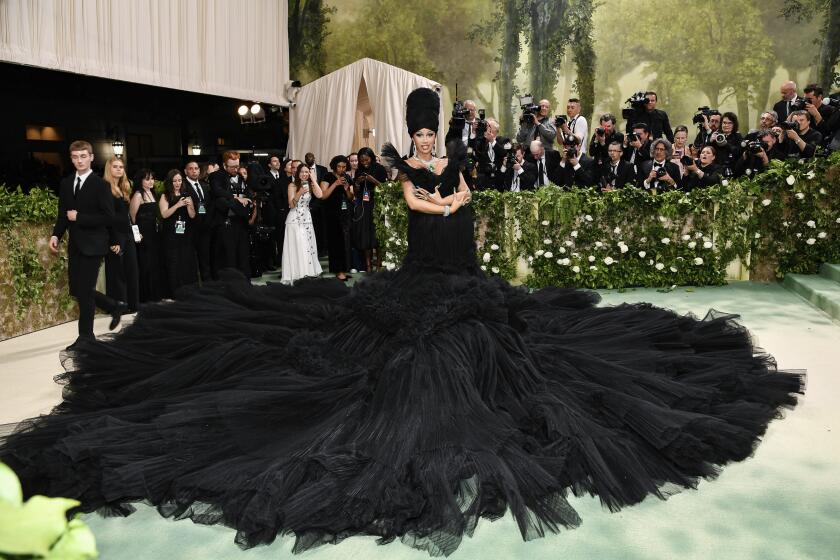Companies Too Often Look for ‘Safe’ Causes
Waiting for a cab one night in New York, I saw a purplish van drive up. In the dusk, I could see a huge pair of lips and the words “Kiss Goodbye to Breast Cancer--Join the Avon Breast Cancer Crusade, Call Your Representative 1-800-FOR AVON.”
The van, it turns out, was promoting a line of lipstick, part of Avon’s ongoing “cause marketing” campaign that links its cosmetics with a nasty disease that resonates among the company’s female sales staff, customers and women everywhere. The lipsticks, which sported such names as Strength and Courageous Spirit, sold for $4 during the fall, with $1 of each sale going toward breast cancer funding.
What makes breast cancer so appealing as a business proposition not only for Avon but also for Saks, Ford Motor Co., J.C. Penney Co. and others that engage in a relatively new type of marketing that links a portion of a company’s sales to a charitable cause? “Breast cancer is safe,” said Carol Cone, chief executive of a Boston public relations firm that helped develop Avon’s breast cancer campaign in 1993.
*
Not ‘Scary’ or ‘Ugly’
It’s also a broad issue that reflects positively on the company, Cone says. Virtually every woman knows someone who has had the disease, which is the leading cause of death among women 35 to 54--a group many marketers try to reach. By contrast, she added, few companies want to link their sales and brand to an issue like violence against children, which, as Cone put it, is “edgy, scary and ugly.”
Avon officials say the company’s breast cancer campaign has raised more than $155 million since 1993. That’s no shabby amount, and that money has certainly funded some worthwhile activities, including research for a cure. But I couldn’t help thinking about all the other health-care needs we have in this country and why few companies are eager to tie their brands to them. Surely other diseases are equally devastating. I haven’t seen, for example, any companies that make men’s grooming products promote razors or shaving cream along with a cure for prostate cancer.
Other major killers, such as heart disease, haven’t caught on with cause marketers because, unlike breast cancer, heart ailments often take a long time to manifest themselves and are related more closely to behavior. With breast cancer, said Cone, “you can be dead in six months or a year.” In other words, if you eat fatty foods you might get heart disease someday; if you smoke, you might get lung cancer-diseases tinged with moral overtones that resonate with corporate America as more controversial.
It’s a rare company that will link its products with an illness associated with the elderly. Cone said she has been unsuccessful in interesting companies in menopause because companies want to “show younger in their imagery.” So advocates for diseases that skew older struggle to find corporate and celebrity champions to push their cause.
Take glaucoma, for example, which is the leading cause of preventable blindness, affecting 3 million to 4 million Americans, not all of them old. Some 250,000 people younger than 35 have the disease. And African Americans are much more likely than Caucasians to go blind from the disease. Glaucoma, though, is not glamorous. The Glaucoma Foundation in New York, which gives small research grants, had an endowment of only $1 million.
One of the Glaucoma Foundation’s biggest donors, the New York bond trading firm Cantor Fitzgerald, lost 700 of its 1,000 employees in the World Trade Center attack. “We lost so many friends and supporters,” says Jim Digan, the foundation’s president. He estimates that the foundation’s donations will drop by $750,000 this year.
*
Money for Screening
In California, health charities ranging from community clinics that serve poor people to community food programs for the elderly are hurting for money, as donors redirect their charitable giving to causes related to Sept. 11, which now seem more compelling to many donors.
In the meantime, millions continue to pour into the breast cancer crusade. Avon’s efforts have been so successful that its foundation now gives the government money for research. The National Cancer Institute received what Avon calls an “unprecedented” gift of $20 million, “the largest corporate foundation award of its kind bestowed on this government agency.”
Avon’s crusade, worthy as it may be, illustrates the piecemeal approach to health care in this country and the inequity of the system in providing for citizens’ basic needs. “We see breast cancer as a paradigm for what happens in the health-care system around the treatment and prevention of disease and how people are treated,” said Barbara Brenner, executive director of Breast Cancer Action, a San Francisco-based advocacy group that has been critical of Avon’s emphasis on preventive screening rather than direct treatment.
Private charities, of course, can decide how to spend their money. The problem is, their priorities may not always match the needs of the sick. Much of Avon’s money goes to screening women for breast cancer, education and support services like providing transportation to mammography sites and elder care or child care for women undergoing treatment. Although Avon’s foundation has made some money available for diagnostic tests, little goes for treatment, which is costly.
Under two-year funding gifts that Avon is providing to national cancer centers, including clinics at UC San Francisco and UC Irvine, about $500,000 will go toward paying for actual treatment for low-income women. Considering that the cost of treating a single breast cancer patient can approach $100,000, that’s not a lot of money. Kathleen Walas, president of the Avon Products Foundation, noted that the company is “not in the insurance business. Our job is to make sure woman are educated. The medically underserved are probably covered by Medicaid or free mammography programs.”
*
Low-Income Treatment
In California, a new law will provide treatment for low-income women eligible for breast and cervical cancer screening under certain government-funded programs. But uninsured women whose monthly incomes exceed $1,432 may still fall through the cracks. And so will poor women in communities untouched by Avon’s gifts. In Mendocino, Sara O’Donnell, who runs the Cancer Resource Center on a shoestring annual budget of $140,000, worries that money leaves the community when residents give money to participate in Avon walks in San Francisco.
Championing diseases has become a popularity contest that magnifies the disparities in the nation’s health-care system. Getting care to sick people, especially the poor, should not depend on what’s popular at the moment. These contests may effectively raise money and satisfy corporate objectives, but they are hardly the blueprint for defeating disease.
*
E-mail: trudyal530@aol.com. Health Matters runs on the third Monday of the month.






